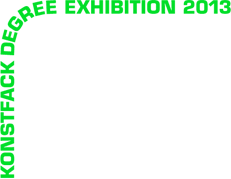Master / Textile in the Expanded Field
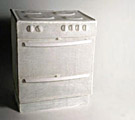
Brynja Helga Kjartansdóttir
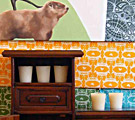
Hale Güngör Oppenheimer
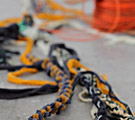
Karin Bäckström
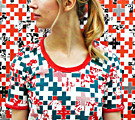
Kristine Leimanis de Borst
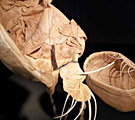
Sandra Lundberg
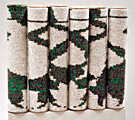
Sandra Zupanic
Sara Reinholtz
Sarin Tasnathepgamol
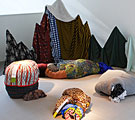
Selene Mauvis
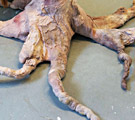
Sol Hanna Eriksson
We fold it, hang it, tear it, make it, replace it and sew it together. It forms the surface on which we stage and negotiate our identities. The events of the world are mirrored in the design of textile material and through textile technology new possibilities are formulated. Humans are so cleaver. We can take a point and explode it. We can take a line and complicate it. The textile shows itself to us and we sense the logic, understand the manufacture, penetrate the system. Around us, above us, below us. From the very first memory to the latest look, we become textile, the textile experience dissolves us and connect humanity across time and space.
In the Master’s group “Textile in the Expanded Field” we contribute to the development of the textile field by working to expand the concepts of art and design. The contexts in which the students work vary greatly, but we are united in our belief that textiles possess the ability to reconfigure the world and help us uncover the knowledge that is required in order to create alternatives. For two years, the master’s students in Textile in the Expanded Field have, through workshop investigations, courses, practical work in the studio and essays, questioned and examined the possibilities and theories of the material.
The textile experience is often not a matter of what it is, but what it does. The performative quality of the material, its history and the contemporary world also leave their mark on the processes that the master’s students have gone through in their various project, and how their work is formulated. In our master’s students’ work we meet external and internal worlds, their voices show us something which we have not previously met, and the personal is political. The work of the students is shaped by an involved view of the world and issues of class, ethnicity, gender and sustainability are formulated and reactivated.
We in Textiles at Konstfack are proud of this year’s students, their work is important and we look forward to following them when they, through their work, formulate a future that is not yet known.
Bella Rune, Professor of Textiles
We present:
Karin Bäckström’s work centers around activity. Creating together is thinking together. Music and craft are connected and the relationship between work, time, performer and audience is questioned and recreated. Bäckström creates a functional social sculpture which, even when it is not activated by music and bodies, holds a promise that we together can formulate new possibilities through intelligent creation.
In Brynja Helga Kjartansdóttir’s installation, the repetition of textile technique and the involuntary repetition of compulsive thought come together. Kjartansdottir makes the figments of our imagination physically tangible, but at the same time the reproduction of a functional object in crochet form also constitutes a apparition, as the function, which is the key to the object’s legitimacy, is removed. Sound and light animate, but also make the frozen even more frozen, and the figments of Kjartansdottir’s imagination become my own.
Sandra Zupanic. A textile animation. There is a tradition of textile translation, and Zupanic plays with it when she translation GIF animations into mechanical sculptures.
In the Master’s group “Textile in the Expanded Field” we contribute to the development of the textile field by working to expand the concepts of art and design. The contexts in which the students work vary greatly, but we are united in our belief that textiles possess the ability to reconfigure the world and help us uncover the knowledge that is required in order to create alternatives. For two years, the master’s students in Textile in the Expanded Field have, through workshop investigations, courses, practical work in the studio and essays, questioned and examined the possibilities and theories of the material.
The textile experience is often not a matter of what it is, but what it does. The performative quality of the material, its history and the contemporary world also leave their mark on the processes that the master’s students have gone through in their various project, and how their work is formulated. In our master’s students’ work we meet external and internal worlds, their voices show us something which we have not previously met, and the personal is political. The work of the students is shaped by an involved view of the world and issues of class, ethnicity, gender and sustainability are formulated and reactivated.
We in Textiles at Konstfack are proud of this year’s students, their work is important and we look forward to following them when they, through their work, formulate a future that is not yet known.
Bella Rune, Professor of Textiles
We present:
Karin Bäckström’s work centers around activity. Creating together is thinking together. Music and craft are connected and the relationship between work, time, performer and audience is questioned and recreated. Bäckström creates a functional social sculpture which, even when it is not activated by music and bodies, holds a promise that we together can formulate new possibilities through intelligent creation.
In Brynja Helga Kjartansdóttir’s installation, the repetition of textile technique and the involuntary repetition of compulsive thought come together. Kjartansdottir makes the figments of our imagination physically tangible, but at the same time the reproduction of a functional object in crochet form also constitutes a apparition, as the function, which is the key to the object’s legitimacy, is removed. Sound and light animate, but also make the frozen even more frozen, and the figments of Kjartansdottir’s imagination become my own.
Sandra Zupanic. A textile animation. There is a tradition of textile translation, and Zupanic plays with it when she translation GIF animations into mechanical sculptures.
Pixels become glass beads in Zupanic’s work, and associations and connections between global online trade and the glass bead as an ancient symbol of (unfair) trade gives the work many layers. She looks for textile sensuality in the digital and for digital seduction in the textile.
Hale Güngör Oppenheimer’s paintings give us a sense of alienation, the animals in the painting never look directly at us – they avoid our glances and look at something outside of the picture. The depicted objects, which we meet not only in the paintings, but also as sculptures, seem lost, despite their everyday nature and they belong in a certain cultural everyday context becoming clear. Hale Güngör Oppenheimer uses textile prints that reappear in the room and inside the frames of the paintings; they exist in the painting and in the room in the same scale 1:1, this connection dissolves the line between us and them, between representation and reality. Questions of homelessness and cultural alienation drive Hale Güngör Oppenheimer’s artistry.
Kristine Leimanis is fascinated by the richness of the imagery which is posted online, where still lives featuring food and gadgets are proudly displayed. Leimanis collects images that have been posted using a specific hash tag, for example #I love, and uses these images to create her patterns. In Leimanis’ pattern world the everyday life presented online is questioned and celebrated.
In Sandra Lundberg’s work, the body, craft, death and a lifelong relationship to Michael Jackson are all melded together. The physically tangible rubs against the intangibly perfect. Whiteness, gender and the belonging and possibilities of various bodies are explored as she allows the material to collide and meld.
Homo Ludens, the playing human, is a way into Sara Reinholtz’s world. She wants us to tell stories together. Her starting point is a toy, known as Mandala, which can be rotated and manipulated to create new forms and inspire new narratives through its use. Reinholtz scales this toy up and gives us the ability to shape the rooms where we can meet, converse and discuss in new ways.
Sarin Tasnathepgamol wants to remind us of the transient nature of our existence. With her textile work she wants to sensitize us to the constant changes the natural world and the fragility of the now. She manipulates materials to visualize time, a color correct embroidered edge directly on a leaf becomes the memory of embroidery as the leaf withers, and coloring techniques that show the drop of color’s path in a bath of water freezes the instant. Nothing is forever. This is important.
Selene Mauvis collects things and images that are no longer wanted and creates new narratives. She is interested in what a designer’s role can be, and questions her own possibilities of contributing in this field. Her work is clearly about reuse and sustainability, but she also gives us the tools to connect things that are familiar to us in entirely new ways, and this service may reveal the most sustainable role of a designer.
Sol Hanna Eriksson uses animal materials. Wool. Pike skin. Moose teeth. She tans, felts and dies her way into her contemporary practice. Eriksson creates works that problematize our contemporary longing for nature, for a simpler time, something more magical. In her installation she makes us view these materials in new ways and we literally kneel before this wonder.
Hale Güngör Oppenheimer’s paintings give us a sense of alienation, the animals in the painting never look directly at us – they avoid our glances and look at something outside of the picture. The depicted objects, which we meet not only in the paintings, but also as sculptures, seem lost, despite their everyday nature and they belong in a certain cultural everyday context becoming clear. Hale Güngör Oppenheimer uses textile prints that reappear in the room and inside the frames of the paintings; they exist in the painting and in the room in the same scale 1:1, this connection dissolves the line between us and them, between representation and reality. Questions of homelessness and cultural alienation drive Hale Güngör Oppenheimer’s artistry.
Kristine Leimanis is fascinated by the richness of the imagery which is posted online, where still lives featuring food and gadgets are proudly displayed. Leimanis collects images that have been posted using a specific hash tag, for example #I love, and uses these images to create her patterns. In Leimanis’ pattern world the everyday life presented online is questioned and celebrated.
In Sandra Lundberg’s work, the body, craft, death and a lifelong relationship to Michael Jackson are all melded together. The physically tangible rubs against the intangibly perfect. Whiteness, gender and the belonging and possibilities of various bodies are explored as she allows the material to collide and meld.
Homo Ludens, the playing human, is a way into Sara Reinholtz’s world. She wants us to tell stories together. Her starting point is a toy, known as Mandala, which can be rotated and manipulated to create new forms and inspire new narratives through its use. Reinholtz scales this toy up and gives us the ability to shape the rooms where we can meet, converse and discuss in new ways.
Sarin Tasnathepgamol wants to remind us of the transient nature of our existence. With her textile work she wants to sensitize us to the constant changes the natural world and the fragility of the now. She manipulates materials to visualize time, a color correct embroidered edge directly on a leaf becomes the memory of embroidery as the leaf withers, and coloring techniques that show the drop of color’s path in a bath of water freezes the instant. Nothing is forever. This is important.
Selene Mauvis collects things and images that are no longer wanted and creates new narratives. She is interested in what a designer’s role can be, and questions her own possibilities of contributing in this field. Her work is clearly about reuse and sustainability, but she also gives us the tools to connect things that are familiar to us in entirely new ways, and this service may reveal the most sustainable role of a designer.
Sol Hanna Eriksson uses animal materials. Wool. Pike skin. Moose teeth. She tans, felts and dies her way into her contemporary practice. Eriksson creates works that problematize our contemporary longing for nature, for a simpler time, something more magical. In her installation she makes us view these materials in new ways and we literally kneel before this wonder.
Den fladdrar. Vi viker ihop, hänger upp, sliter av, byter ut och syr ihop den. Den bildar den yta på vilken vi iscensätter och förhandlar våra identiteter. Världens skeende återspeglas i det textila materialets utformning och genom textil teknik formuleras nya möjligheter. Människan är så smart, vi kan ta en punkt och explodera den. Vi kan ta en linje och komplicera den. Textilen visar sig för oss och vi förnimmer logiken, förstår tillverkningen, tränger in i systemet. Runt oss, över oss och under oss. Det första minnet och det allra senaste. Vi blir textil, textilen löser upp oss och kopplar ihop oss över tiden och med planeten.
På Textil i det utvidgade fältet bidrar vi till det textila fältets utveckling genom att verka för ett vidgat konst- och designbegrepp. De sammanhang som studenterna jobbar mot är vitt skilda, men vi förenas i en tro på att det, i det textila, finns möjlighet att omformulera världen och fördjupa de kunskaper som behövs för att skapa alternativ. Under två år har studenterna i mastergruppen Textil i det utvidgade fältet genom verkstadsundersökningar, kurser, ateljépraktik och essäer ifrågasatt och undersökt materialets möjligheter och teorier.
Upplevelsen av det textila är ofta inte av vad det är, utan vad det kan göra. Den performativa kvalitén i materialet, dess historia och samtid präglar också de processer som studenterna i mastergruppen gått igenom i sina olika projekt och hur deras verk formuleras. I våra masterstudenters arbeten möter vi yttre och inre världar, deras röster visar oss något vi inte tidigare mött och det personliga är det politiska. Studenternas praktiker formas utifrån en engagerad syn på omvärlden och frågor om klass, etnicitet, kön och hållbarhet formuleras och återaktiveras.
Vi på Textil är stolta över årets studenter, deras arbeten är viktiga och vi ser fram emot att följa dem när de genom sina praktiker formulerar en framtid som ännu inte är känd.
Bella Rune, professor i textil
Vi presenterar:
Karin Bäckströms arbete kretsar kring aktivitet. Att göra tillsammans är att tänka tillsammans. Musik och hantverk kopplas ihop och relationen mellan verk, tid, utövare och åskådare ifrågasätts och återskapas. Bäckstöm skapar en funktionell social skulptur som, även när den inte är aktiverad med musik och kroppar, bär på ett löfte om att vi tillsammans kan vi formulera nya möjligheter genom det intelligenta görandet.
I Brynja Helga Kjartansdóttirs installation möts den textila teknikens repetition och tvångstankens ofrivilliga repeterande. Kjartansdottir gör hjärnspöken till fysiskt påtagliga, men samtidigt är det virkade objektets avbildande av ett funktionellt objekt också ett spöke, då funktionen, som är själva nyckeln till objektets legitimitet, är borttaget. Ljud och ljus animerar, men gör också det frusna mer fruset och Kjartansdottirs hjärnspöken blir mina.
Sandra Zupanic. En textil animation. Det finns en textil översättartradition och den leker Zupanic med den när hon översätter GIF-animationer till mekaniska skulpturer.
På Textil i det utvidgade fältet bidrar vi till det textila fältets utveckling genom att verka för ett vidgat konst- och designbegrepp. De sammanhang som studenterna jobbar mot är vitt skilda, men vi förenas i en tro på att det, i det textila, finns möjlighet att omformulera världen och fördjupa de kunskaper som behövs för att skapa alternativ. Under två år har studenterna i mastergruppen Textil i det utvidgade fältet genom verkstadsundersökningar, kurser, ateljépraktik och essäer ifrågasatt och undersökt materialets möjligheter och teorier.
Upplevelsen av det textila är ofta inte av vad det är, utan vad det kan göra. Den performativa kvalitén i materialet, dess historia och samtid präglar också de processer som studenterna i mastergruppen gått igenom i sina olika projekt och hur deras verk formuleras. I våra masterstudenters arbeten möter vi yttre och inre världar, deras röster visar oss något vi inte tidigare mött och det personliga är det politiska. Studenternas praktiker formas utifrån en engagerad syn på omvärlden och frågor om klass, etnicitet, kön och hållbarhet formuleras och återaktiveras.
Vi på Textil är stolta över årets studenter, deras arbeten är viktiga och vi ser fram emot att följa dem när de genom sina praktiker formulerar en framtid som ännu inte är känd.
Bella Rune, professor i textil
Vi presenterar:
Karin Bäckströms arbete kretsar kring aktivitet. Att göra tillsammans är att tänka tillsammans. Musik och hantverk kopplas ihop och relationen mellan verk, tid, utövare och åskådare ifrågasätts och återskapas. Bäckstöm skapar en funktionell social skulptur som, även när den inte är aktiverad med musik och kroppar, bär på ett löfte om att vi tillsammans kan vi formulera nya möjligheter genom det intelligenta görandet.
I Brynja Helga Kjartansdóttirs installation möts den textila teknikens repetition och tvångstankens ofrivilliga repeterande. Kjartansdottir gör hjärnspöken till fysiskt påtagliga, men samtidigt är det virkade objektets avbildande av ett funktionellt objekt också ett spöke, då funktionen, som är själva nyckeln till objektets legitimitet, är borttaget. Ljud och ljus animerar, men gör också det frusna mer fruset och Kjartansdottirs hjärnspöken blir mina.
Sandra Zupanic. En textil animation. Det finns en textil översättartradition och den leker Zupanic med den när hon översätter GIF-animationer till mekaniska skulpturer.
Pixlar blir till glaspärlor i Zupanics verk och associationer och kopplingar mellan den globala handeln på nätet och glaspärlan som en gammal symbol för (orättvis)handel, ger verket många bottnar. Hon söker efter den textila sensualismen i det digitala och den digitala förförelsen i det textila.
Hale Güngör Oppenheimers målningar försätter oss i en känsla av utanförskap, djuren i målningarna tittar aldrig direkt på oss, de undviker våra blickar och tittar på något utanför bilden. De avbildade objekt vi möter i målningarna, men också som skulpturer, verkar vilsna, trots sin vardagliga natur och deras hemvist i en viss kulturell vardag blir tydlig. Hale Güngör Oppenheimer använder textila tryck som återkommer i rummet och innanför målningarnas ramar, de vistas i målningen och i rummet i samma skala 1:1, denna hopkoppling löser upp linjen mellan vi och dem, mellan representation och realitet Frågor kring hemlöshet och kulturellt utanförskap driver Hale Güngör Oppenheimers konstnärskap.
Kristine Leimanis fascineras av det rika bildmaterial som läggs upp på nätet, där stilleben av mat och prylar stolt visas upp. Leimanis samlar de bilder som lagts upp under en viss hashtag, som t. ex #I love, och använder bildmaterialet för att skapa sina mönster. I Leimanis mönstervärld ifrågasätts och hyllas den vardag som presenteras på nätet.
I Sandra Lundbergs verk samsas kroppen, hantverket, döden och en livslång relation till Michael Jackson. Det fysiskt påtagliga gnuggas mot det oåtkomligt perfekta. Vithet, kön och olika kroppars tillhörighet och möjligheter utforskas när hon låter materialet krocka och förenas.
Sara Reinholtz. Homo Ludens, den lekande människan är en väg in i Reinholtz värld. Hon vill att vi berättar tillsammans. Utgångspunkten är en leksak, som kallas Mandala, som kan vridas och vändas för att skapa nya former och inspirerar till nya narrativ genom användande. Reinholtz skalar upp leksaken och ger oss möjligheten att forma de rum där vi kan mötas, samtala och konferera på nya sätt.
Sarin Tasnathepgamol vill påminna oss om det förgängliga i vårt varande. Med sina textila verk vill hon känsliggöra oss för naturens ständiga förändring och det sköra nuet. Hon manipulerar material så att tiden blir synlig, en färgkorrekt brodyr direkt på bladet blir till ett brodyrminne då lövet vissnat och färgtekniker som vittnar om färgdroppens väg i vattenbadet fryser det korta nuet. Inget är för evigt. Det är viktigt.
Selene Mauvis kastar sig över saker och bilder som ingen längre vill ha och skapar nya narrativ. Hon intresserar sig för vad en designerroll kan vara och ifrågasätter sina egna möjligheter i detta fält. Klart är att det handlar om återbruk och hållbarhet, men hon ger oss också verktyg att koppla samman de saker vi känner väl på helt nya sätt, och denna tjänst visar kanske på den mest hållbara designerrollen av alla.
Sol Hanna Eriksson använder animaliska material. Ull. Gäddskinn. Älgtänder. Hon garvar, tovar och torkar sig in i sin samtida praktik. Eriksson gör verk som problematiserar vår tids längtan till naturen, till en enklare tid, något mer magiskt. I sin installation får hon oss att se dessa material på nya sätt och vi knäböjer bokstavligen inför detta under.
Hale Güngör Oppenheimers målningar försätter oss i en känsla av utanförskap, djuren i målningarna tittar aldrig direkt på oss, de undviker våra blickar och tittar på något utanför bilden. De avbildade objekt vi möter i målningarna, men också som skulpturer, verkar vilsna, trots sin vardagliga natur och deras hemvist i en viss kulturell vardag blir tydlig. Hale Güngör Oppenheimer använder textila tryck som återkommer i rummet och innanför målningarnas ramar, de vistas i målningen och i rummet i samma skala 1:1, denna hopkoppling löser upp linjen mellan vi och dem, mellan representation och realitet Frågor kring hemlöshet och kulturellt utanförskap driver Hale Güngör Oppenheimers konstnärskap.
Kristine Leimanis fascineras av det rika bildmaterial som läggs upp på nätet, där stilleben av mat och prylar stolt visas upp. Leimanis samlar de bilder som lagts upp under en viss hashtag, som t. ex #I love, och använder bildmaterialet för att skapa sina mönster. I Leimanis mönstervärld ifrågasätts och hyllas den vardag som presenteras på nätet.
I Sandra Lundbergs verk samsas kroppen, hantverket, döden och en livslång relation till Michael Jackson. Det fysiskt påtagliga gnuggas mot det oåtkomligt perfekta. Vithet, kön och olika kroppars tillhörighet och möjligheter utforskas när hon låter materialet krocka och förenas.
Sara Reinholtz. Homo Ludens, den lekande människan är en väg in i Reinholtz värld. Hon vill att vi berättar tillsammans. Utgångspunkten är en leksak, som kallas Mandala, som kan vridas och vändas för att skapa nya former och inspirerar till nya narrativ genom användande. Reinholtz skalar upp leksaken och ger oss möjligheten att forma de rum där vi kan mötas, samtala och konferera på nya sätt.
Sarin Tasnathepgamol vill påminna oss om det förgängliga i vårt varande. Med sina textila verk vill hon känsliggöra oss för naturens ständiga förändring och det sköra nuet. Hon manipulerar material så att tiden blir synlig, en färgkorrekt brodyr direkt på bladet blir till ett brodyrminne då lövet vissnat och färgtekniker som vittnar om färgdroppens väg i vattenbadet fryser det korta nuet. Inget är för evigt. Det är viktigt.
Selene Mauvis kastar sig över saker och bilder som ingen längre vill ha och skapar nya narrativ. Hon intresserar sig för vad en designerroll kan vara och ifrågasätter sina egna möjligheter i detta fält. Klart är att det handlar om återbruk och hållbarhet, men hon ger oss också verktyg att koppla samman de saker vi känner väl på helt nya sätt, och denna tjänst visar kanske på den mest hållbara designerrollen av alla.
Sol Hanna Eriksson använder animaliska material. Ull. Gäddskinn. Älgtänder. Hon garvar, tovar och torkar sig in i sin samtida praktik. Eriksson gör verk som problematiserar vår tids längtan till naturen, till en enklare tid, något mer magiskt. I sin installation får hon oss att se dessa material på nya sätt och vi knäböjer bokstavligen inför detta under.
